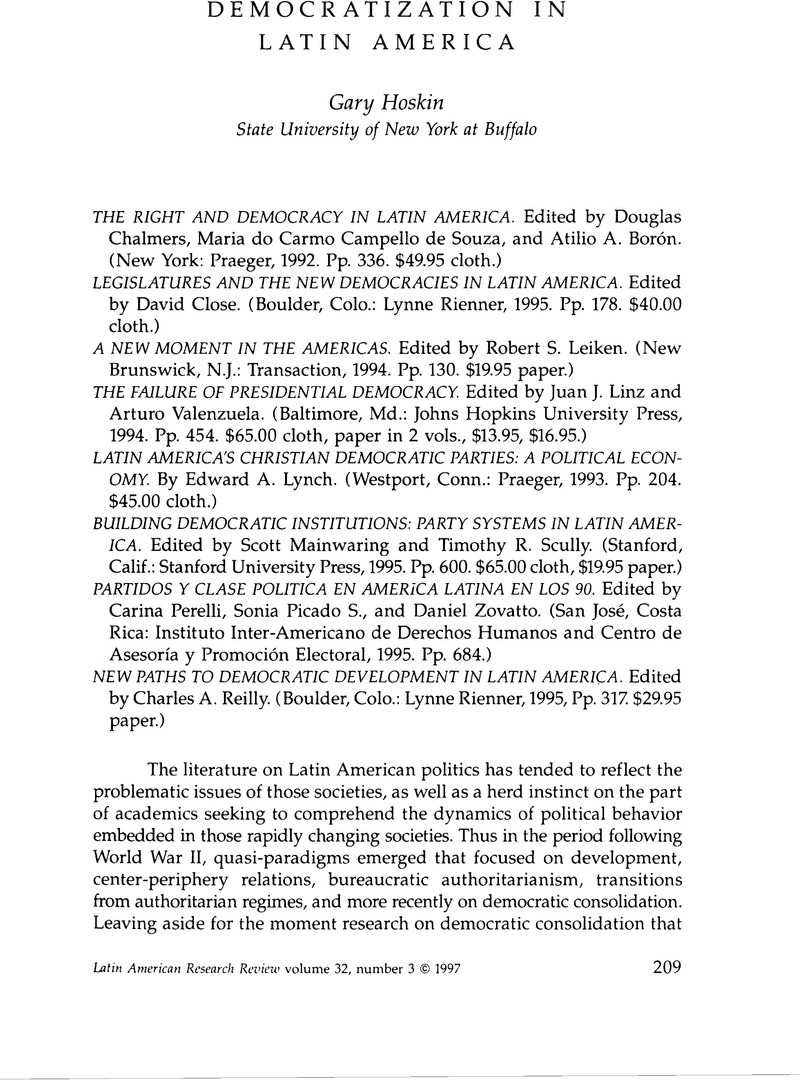Article contents
Democratization in Latin America
Review products
Published online by Cambridge University Press: 05 October 2022
Abstract

- Type
- Review Essays
- Information
- Copyright
- Copyright © 1997 by the University of Texas Press
References
Notes
1. For a critique of the Latin American literature that emphasizes its parochialism, see John Martz, “Political Science and Latin American Studies: Patterns and Asymmetries of Research and Publication,” LARR 25, no. 1 (1990):67–86. Also consult Karen Remmer's penetrating insights into the theoretical weaknesses of the democratization literature in “New Wine or Old Bottlenecks? The Study of Latin American Democracy,” Comparative Politics 23, no. 4 (July 1991):479–95.
2. Albert Hirschman, Journeys toward Progress (Garden City, N.Y.: Doubleday, Anchor Books, 1965), 309–13.
3. Albert Hirschman, “The Political Economy of Latin American Development: Seven Exercises in Retrospection,” LARR 22, no. 3 (1987):7–36.
4. Marcelo Cavarozzi, “Beyond Transitions to Democracy in Latin America,” paper presented to the Latin American Studies Association, 4–6 Apr. 1991, Washington, D.C., p. 9.
5. John Williamson, “What Washington Means by Policy Reform,” in Latin American Adjustment: How Much Has Happened?, edited by Williamson (Washington, D.C.: Institute for International Economics, 1990), 5–38.
6. Samuel Huntington, The Third Wave: Democratization in the Late Twentieth Century (Norman: University of Oklahoma Press, 1991).
7. Mitchell A. Seligson, “Democracy in Latin America: The Current Cycle,” in Authoritarians and Democrats: Regime Transition in Latin America, edited by James M. Malloy and Mitchell A. Seligson (Pittsburgh, Pa.: University of Pittsburgh Press, 1987), 3–12.
8. Karen Remmer, “The Political Impact of Economic Crisis in Latin America in the 1980s,” American Political Science Review 85, no. 3 (Sept. 1991):777–800.
9. Robert Dahl utilized the concept of polyarchy rather than democracy, recognizing that no government ever becomes fully democratic. Thus polyarchies are those governments that approach democratic norms and practices. For an elaboration of the model, see Dahl's Polyarchy: Participation and Opposition (New Haven, Conn.: Yale University Press, 1971). This model concentrated almost exclusively on political variables at the expense of economic and social factors. But in responding to criticism, Dahl reformulated his thinking in A Preface to Economic Democracy (Cambridge, Mass.: Polity, 1985) and in Democracy and Its Critics (New Haven, Conn.: Yale University Press, 1989), extending his scope well beyond political variables. Latin Americanists turned to the concept of polyarchy to analyze Latin American democracies, initially focusing on its political dimensions but later modifying them and extending the scope to economic and social factors. See Guillermo O'Donnell, “Illusions about Consolidation,” journal of Democracy 7, no. 2 (Apr. 1966):34–51.
10. For a discussion of what Guillermo O'Donnell labels as “the second democratic transition,” see “Delegative Democracy,” Journal of Democracy 5, no. 1 (Jan. 1994):56–69.
11. Ibid.
12. Remmer, “Political Impact of Economic Crisis.”
13. Adam Przeworski, Michael Alvarez, José Antonio Cheibub, and Fernando Limongi, “What Makes Democracies Endure?” Journal of Democracy 7, no. 1 (Jan., 1996):39–55.
14. For an excellent analysis of the role of technocrats in the policy process in Bolivia, Ecuador, and Peru, see Catherine M. Conaghan and James M. Malloy, Unsettling Statecraft: Democracy and Neoliberalism in the Central Andes (Pittsburgh, Pa.: University of Pittsburgh Press, 1994).
15. Matthew Soberg Shugart, “Economic Adjustment and Political Institutions: Foreign versus Domestic Constituents in Colombia,” manuscript, 1992.
16. Matthew Soberg Shugart and John M. Carey, Presidents and Assemblies: Constitutional Design and Electoral Dynamics (New York: Cambridge University Press, 1992).
17. I would argue that similar difficulties in sustaining citizen participation have occurred in Colombia and Venezuela, despite political reforms that have facilitated citizen involvement in political life.
18. Philippe Schmitter, “The Consolidation of Democracy and Representation of Social Groups,” American Behavioral Scientist 35 (Mar.–June 1992):422–49.
19. O'Donnell, “Illusions about Consolidation,” 43–46.
- 14
- Cited by




